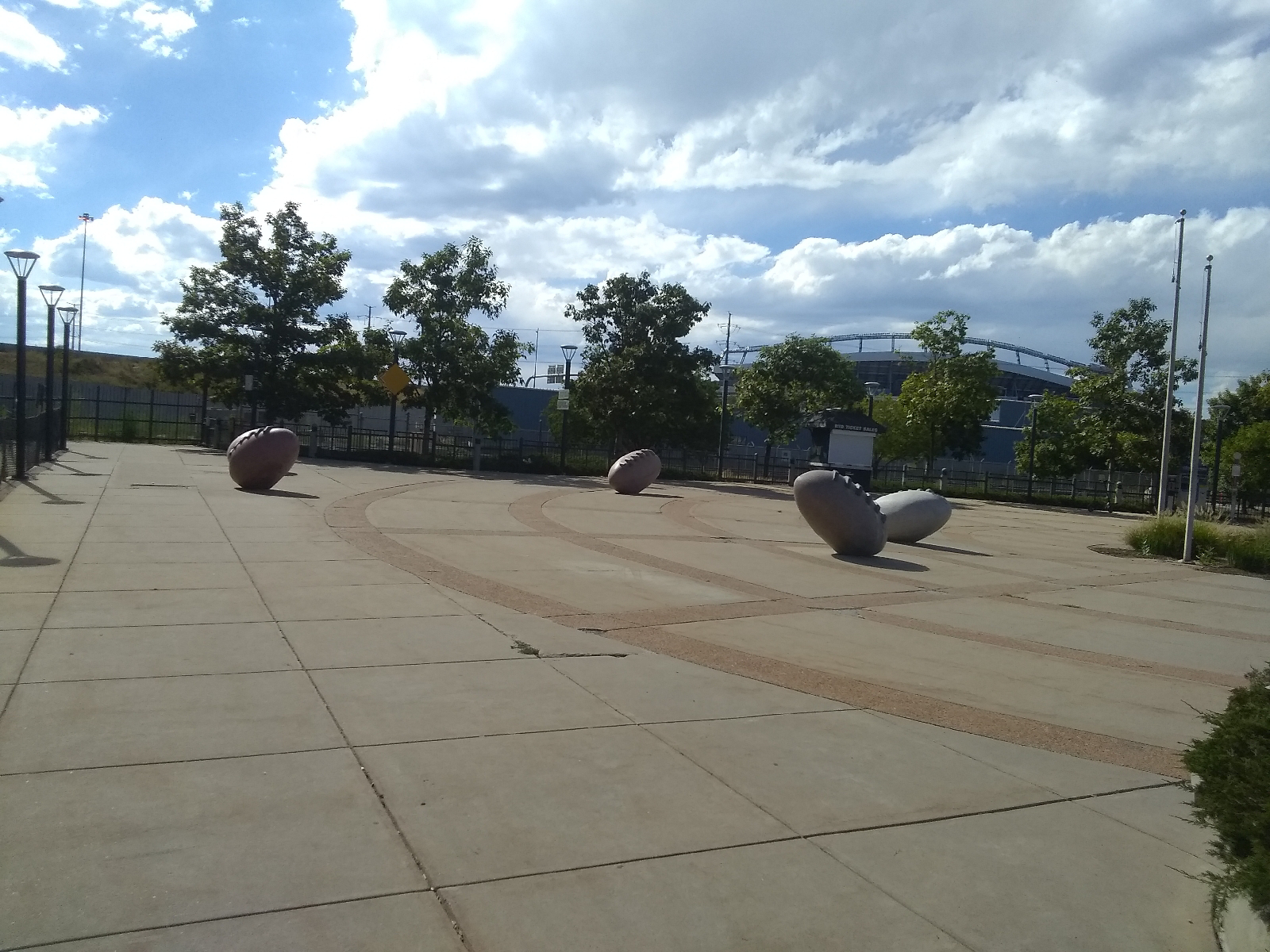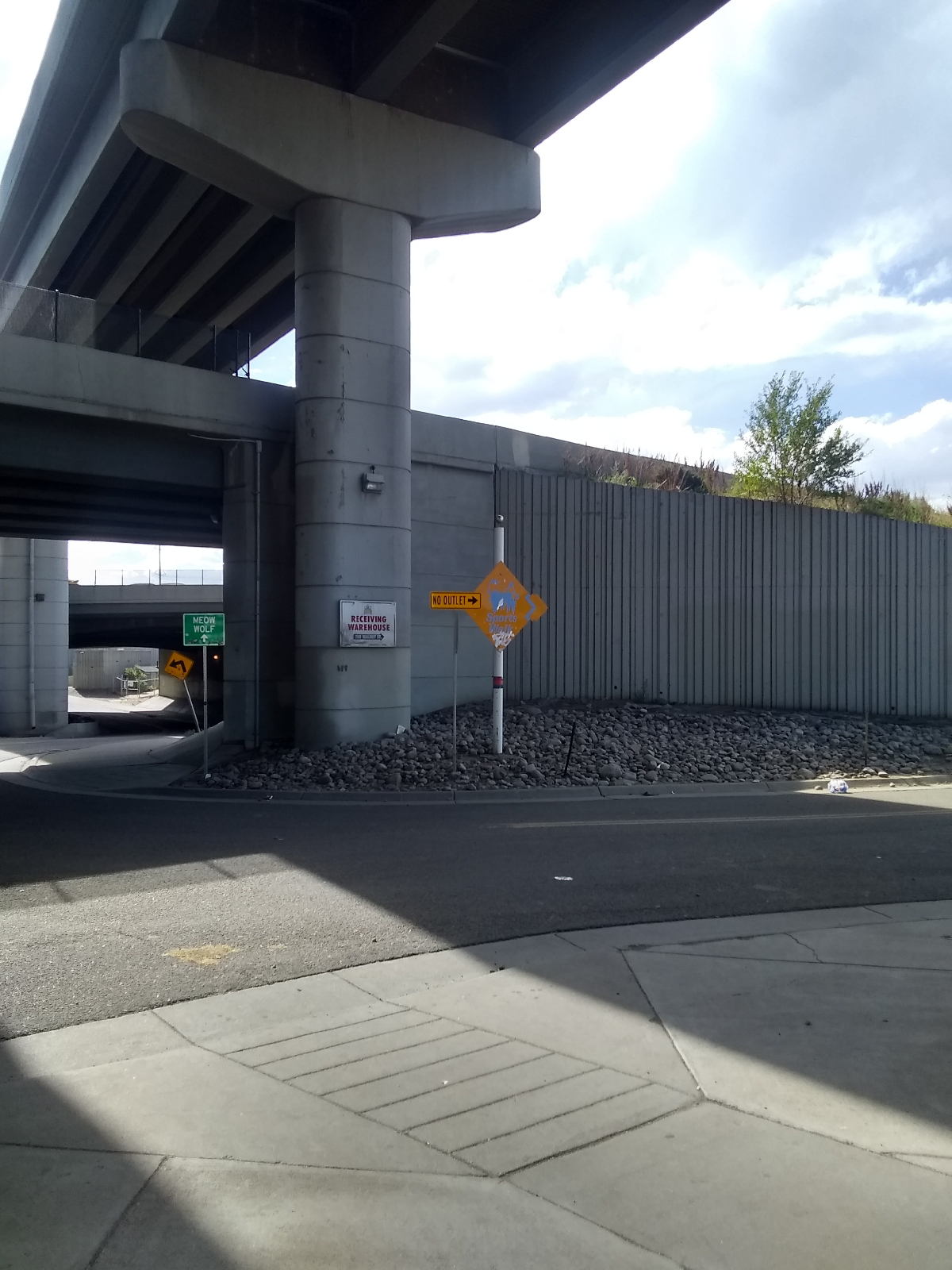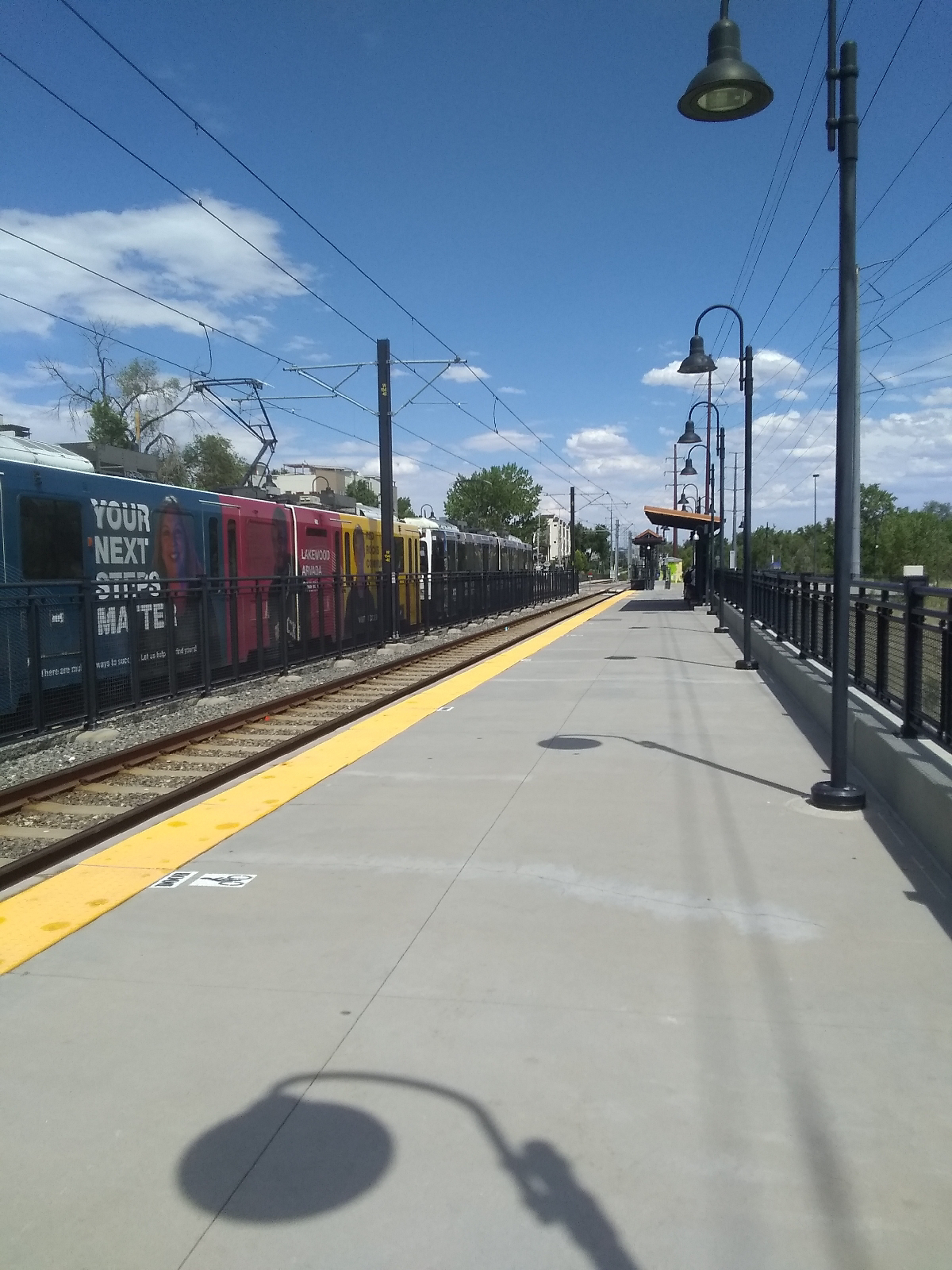If I had hiked from Auraria West to Empower Stadium Station, it would have taken about ten minutes and I would have seen...an empty field. So I hiked from Auraria West to Empower Stadium and then followed the South Platte River around Elitch Gardens to the Ball Arena and Elitch Gardens Station. That was a respectable hike with some interesting sights.
The reason these three stations are so close together is that each services a major destination in Denver. Auraria West provides transportation options for the Auraria West college campus. The Empower Stadium Station is one of two RTD gateways to the home of the Denver Broncos, shown here in the distance. The other is the Decatur-Federal Station.
Shown here again from the RTD station, Empower Stadium can arguably be called the centerpiece of Denver.
If you drive through Denver going anywhere else, you will probably be on either I25 (going north-south), or I70 (going east-west). Either way, you pass by the stadium. Denver is also sports intensive and their pride and joy is the Broncos pro-football team. The trains are packed beyond capacity on game days.
If there's any question about the theme of Empower Stadium Station, there's a courtyard with sculptures of footballs lying around. Kick one of those, Charlie Brown.
This sculpture, Pigskins, by Troy Corliss, presents images of five footballs from different eras of the sport.
One end of the Sports Walk trail is at this station (the other is at the Decatur-Federal Station). From here it is a short distance under Interstate 25 and over the South Platte River to Empower Field at Mile High.
If you enlarge this last picture, you can see that water fowl congregate here. If you visit, take note that the water is polluted...this is no place to go swimming.
Empower Field has had several names since it was built in 2001: Invesco Field, Sports Authority Field, and Broncos Stadium. It serves as home to several other sports teams in Denver and also hosts other events such as concerts. It was the site of Barach Obama's acceptance of the Democratic presidential nomination in 2008.
The name "Empower" is from the current corporate partner, Empower Retirement. The stadium has quite a varied history including a fire on March 24, 2022 but I will direct you to the Wikipedia article, https://en.wikipedia.org/wiki/Empower_Field_at_Mile_High, for all that.
On the day I visited, I couldn't get to the entrance due to an event, Taste of the Broncos (not as bad as it sounds...they weren't eating the Broncos), but I had a brief but friendly conversation with one of the security people.
Empower Stadium is also the home of the Colorado Sports Hall of Fame.
The brick wall displays plaques with lists of Colorado sports luminaries since 1965, the year it was established. Here's the plaque for 2014. What sports did they excel in? Well, there are a lot of names. I'll let you look them up.
Leaving Empower Field, I backtracked along the Sports Walk Trail to where the South Platte River Trail split off. Following the river, that carried me around behind Elitch Gardens.
Elitch Gardens is a privately owned, for profit amusement park in downtown Denver. Since it's opening in 1890, it has passed through several hands and is currently owned by Premier Parks LLC (I think... it's sorta hard to keep up with who owns it.). There has been rumors for some time that the area will be redeveloped as this or that, and the park will be moved or not moved, or shut down.
Regardless, it is the densest park I have ever seen. A surprising array of attractions including the rides, shows, concessions, a water park, and a botanical gardens, is crammed tightly into a very small space.
I've lost interest in amusement parks since my heart's mitral valve went on strike about 15 years ago. A person can do well enough without a mitral valve, many do, but they feel it when they're working horizontally or upside down (like under a sink or car), and increased g forces (like on a rollercoaster) can really cause problems. The mitral valve can be replaced (my sister-in-law had it done with good results) but it's a very invasive procedure that needs a very experienced surgeon.
The mitral valve is a one-way valve that keeps blood coming from the lungs into the heart from backing up into the lungs (it's called "mitral valve regurgitation"). Positive pressure from the lungs side also pushes blood on into the heart. Gravity helps as long as I'm upright. Activity also helps since the valves in the veins of my limbs work to push blood back toward my heart.
So, to keep my mitral valve in tone, I kept walking. The underpass at Speer Boulevard has a big mural. Since we now have a Fox in the family, I took a picture of this.
Speer parallels Cherry Creek, a tributary of the South Platte River that I haven't explored nearly enough. It arises from the area around Castle Rock, to the south of home, and joins the river in downtown Denver. Trails run along Cherry Creek throughout most of its length. The predecessor of Denver, Auraria, lounged between the South Platte and Cherry Creek. Denver was originally settled across the creek from Auraria. There is a block of the original Auraria on the Auraria college campus. (See the November 10, 2017 blog, Auraria West to Osage.)
In downtown Denver, Cherry Creek is lined with parks and railroads. There are also several old steel truss foot bridges. Denver should be a magnet for people who are interested in bridges.
A short walk across Speer brings me to my last stop on the hike, the Ball Arena/Elitch Gardens Station.
As always, there is art - Seven Sisters, by Dave Griggs, welcome light rail passengers to the recreation intensive Platte River Valley section of Downtown Denver.
The Ball Arena (once named the Pepsi Center) is a venue for a variety of sport events, concerts, and other shows. Although the location was purchased by Ball Corporation and renamed the Ball Arena in 2020, tradition dies hard and people still talk about the Pepsi Center here.
This RTD station also services Elitch Gardens and is very near the Auraria Campus.
Recreation is important for communities. It's where people come together to share positive experiences. It encourages bonding. All communities have recreational venues. Denver and Atlanta are large cities and you can find pretty much anything you want there. My early childhood was spent in LaGrange, Georgia and both Atlanta and Columbus, Georgia were nearby. LaGrange and Columbus are sizeable towns with many attraction, but even the small towns where I lived for many years, Valley and Selma, Alabama, had parks, auditoriums, gymnasiums, and local eateries that served as cultural centers.
Recreational attractions provide important services to communities, but they also have history and place and host art. A large part of lifelong learning is to dig deeply for what Paul Harvey used to call "the rest of the story." It's an engaging and profitable adventure. Dig up your town's "rest of the story." It'll take you places you never expected to go.





























































